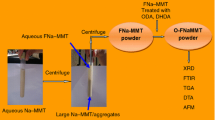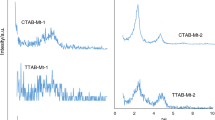Abstract
Organically modified clay minerals with high thermal stability are critical for synthesis and processing of clay-based nanocomposites. Two series of organo-montmorillonites have been synthesized using surfactants with different alkyl chain length. The organo-montmorillonites were characterized by X-ray diffraction and differential thermogravimetry, combining with molecule modelling. For surfactant with relatively short alkyl chain, the resultant organo-montmorillonite displays a small maximum basal spacing (ca. 1.5 nm) and most surfactants intercalate into montmorillonite interlayer spaces as cations with a small amount of surfactant molecules loaded in the interparticle pores with “house-of-cards” structure. However, for surfactant with relatively long alkyl chain, the resultant organo-montmorillonite displays a large maximum basal spacing (ca. 4.1 nm) and the loaded surfactants exist in three formats: intercalated surfactant cations, intercalated surfactant molecules (ionic pairs), and surfactant molecules in interparticle pores. The surfactant molecules (ionic pairs) in interparticle pores and interlayer spaces will be evaporated around the evaporation temperature of the neat surfactant while the intercalated surfactant cations will be evaporated/decomposed at higher temperature.




Similar content being viewed by others
References
Smith JA, Galan A. Sorption of nonionic organic contaminants to single and dual organic cation bentonites from water. Environ Sci Technol. 1995;29:685–92.
Zhu LZ, Chen BL. Sorption behavior of p-nitrophenol on the interface between anion-cation organobentonite and water. Environ Sci Technol. 2000;34:2997–3002.
Shen YH. Preparations of organobentonite using nonionic surfactants. Chemosphere. 2001;44:989–95.
Yilmaz N, Yapar S. Adsorption properties of tetradecyl- and hexadecyl trimethylammonium bentonites. Appl Clay Sci. 2004;27:223–8.
Theng BKG, Churchman GJ, Gates WP, Yuan G. Organically modified clays for pollutant uptake and environmental protection. In: Huang Q, Huang PM, Violante A, editors. Soil mineral microbe organic interactions: theories and applications. Berlin: Springer Verlag; 2008.
He HP, Ma YH, Zhu JX, Yuan P, Qing YH. Organoclays prepared from montmorillonites with different cation exchange capacity and surfactant configuration. Appl Clay Sci. 2010;48:67–72.
Xue SQ, Pinnavaia TJ. Methylene-functionalized saponite: a new type of organoclay with CH2 groups substituting for bridging oxygen centers in the tetrahedral sheet. Appl Clay Sci. 2010;48:60–6.
Lagaly G. Characterization of clays by organic-compounds. Clay Miner. 1981;16:1–21.
Vaia RA, Teukolsky RK, Giannelis EP. Interlayer structure and molecular environment of alkylammonium layered silicates. Chem Mater. 1994;6:1017–22.
Lee SY, Kim SJ. Expansion characteristics of organoclay as a precursor to nanocomposites. Colloids Surf A. 2002;211:19–26.
Zhu JX, He HP, Guo JG, Yang D, Xie XD. Arrangement models of alkylammonium cations in the interlayer of HDTMA+ pillared montmorillonites. Chin Sci Bull. 2003;48:368–72.
He HP, Frost RL, Deng F, Zhu JX, Wen XY, Yuan P. Conformation of surfactant molecules in the interlayer of montmorillonite studied by C-13 MAS NMR. Clays Clay Miner. 2004;52:350–6.
He HP, Ding Z, Zhu JX, Yuan P, Xi YF, Yang D, Frost RL. Thermal characterization of surfactant-modified montmorillonites. Clays Clay Miner. 2005;53:287–93.
He HP, Frost RL, Bostrom T, Yuan P, Duong L, Yang D, Yunfel XF, Kloprogge JT. Changes in the morphology of organoclays with HDTMA+ surfactant loading. Appl Clay Sci. 2006;31:262–71.
Zeng QH, Yu AB, Lu GQ, Standish RK. Molecular dynamics simulation of the structural and dynamic properties of dioctadecyldimethyl ammoniums in organoclays. J Phys Chem B. 2004;108:10025–33.
He HP, Galy J, Gerard JF. Molecular simulation of the interlayer structure and the mobility of alkyl chains in HDTMA+/montmorillonite hybrids. J Phys Chem B. 2005;109:13301–6.
Heinz H, Vaia RA, Krishnamoorti R, Farmer BL. Self-assembly of alkylammonium chains on montmorillonite: effect of chain length, head group structure, and cation exchange capacity. Chem Mater. 2007;19:59–68.
Dana K, Ganguly S, Ghatak S. Thermogravimetric study of n-alkylammonium-intercalated montmorillonites of different cation exchange capacity. J Therm Anal Calorim. 2010;100:71–8.
Hrachova J, Billik P, Fajnor VS. Influence of organic surfactants on structural stability of mechanochemically treated bentonite. J Therm Anal Calorim. 2010;101:161–8.
Yao C, Ni RJ, Huang Y. Thermogravimetric analysis of organoclays intercalated with the gemini surfactants. J Therm Anal Calorim. 2009;96:943–7.
Silva SML, Leite IF, Soares APS, Carvalho LH, Raposo CMO, Malta OML. Characterization of pristine and purified organobentonites. J Therm Anal Calorim. 2010;100:563–9.
Yariv S. The role of charcoal on DTA curves of organo-clay complexes: an overview. Appl Clay Sci. 2004;24:225–36.
Hedley CB, Yuan G, Theng BKG. Thermal analysis of montmorillonites modified with quaternary phosphonium and ammonium surfactants. Appl Clay Sci. 2007;35:180–8.
Sanchez-Martin MJ, del Hoyo C, Dorado C, Rodriguez-Cruz MS. Physico-chemical study of selected surfactant-clay mineral systems. J Therm Anal Calorim. 2008;94:227–34.
Zidelkheir B, Abdelgoad M. Effect of surfactant agent upon the structure of montmorillonite X-ray diffraction and thermal analysis. J Therm Anal Calorim. 2008;94:181–7.
Xie W, Gao ZM, Liu KL, Pan WP, Vaia R, Hunter D, Singh A. Thermal characterization of organically modified montmorillonite. Thermochim Acta. 2001;367:339–50.
Xie W, Gao ZM, Pan WP, Hunter D, Singh A, Vaia R. Thermal degradation chemistry of alkyl quaternary ammonium montmorillonite. Chem Mater. 2001;13:2979–90.
Xie W, Xie RC, Pan WP, Hunter D, Koene B, Tan LS, Vaia R. Thermal stability of quaternary phosphonium modified montmorillonites. Chem Mater. 2002;14:4837–45.
Li YQ, Ishida H. Concentration-dependent conformation of alkyl tail in the nanoconfined space: hexadecylamine in the silicate galleries. Langmuir. 2003;19:2479–84.
Klapyta Z, Fujita T, Iyi N. Adsorption of dodecyl- and octadecyltrimethylammonium ions on a smectite and synthetic micas. Appl Clay Sci. 2001;19:5–10.
Wang CC, Juang LC, Lee CK, Hsu TC, Lee JF, Chao HP. Effects of exchanged surfactant cations on the pore structure and adsorption characteristics of montmorillonite. J Colloid Interface Sci. 2004;280:27–35.
He HP, Zhou Q, Martens WN, Kloprogge TJ, Yuan P, Xi Y, Zhu JX, Frost RL. Microstructure of HDTMA+-modified montmorillonite and its influence on sorption characteristics. Clays Clay Miner. 2006;54:689–96.
Zhu LZ, Zhu RL, Xu LH, Ruan XX. Influence of clay charge densities and surfactant loading amount on the microstructure of CTMA-montmorillonite hybrids. Colloids Surf A. 2007;304:41–8.
Smith W, Forester TR. DL_POLY_2.0: a general-purpose parallel molecular dynamics simulation package. J Mol Graph Model. 1996;14:136–41.
Loewenstein W. The distribution of aluminum in the tetrahedra of silicates and aluminates. Am Miner. 1954;39:92–6.
Cygan RT, Guggenheim S, van Groos AFK. Molecular models for the intercalation of methane hydrate complexes in montmorillonite clay. J Phys Chem B. 2004;108:15141–9.
Dauberosguthorpe P, Roberts VA, Osguthorpe DJ, Wolff J, Genest M, Hagler AT. Structure and enegretics of ligand-binding to proteins—Escherichia-coli dihydrofolate reductase trimethoprim, a drug-receptor system. Proteins. 1988;4:31–47.
Greene-Kelly R. Dehydration of montmorillonite minerals. Miner Mag. 1955;30:604–15.
Xi YF, Zhou Q, Frost RL, He HP. Thermal stability of octadecyltrimethylammonium bromide modified montmorillonite organoclay. J Colloid Interface Sci. 2007;311:347–53.
Chen D, Zhu JX, Yuan P, Yang SJ, Chen TH, He HP. Preparation and characterization of anion-cation surfactants modified montmorillonite. J Therm Anal Calorim. 2008;94:841–8.
Levitz P, Tchoubar D. Disordered porous solids: from chord distributions to small-angle scattering. Journal De Physique I. 1992;2:771–90.
Yuan P, He HP, Bergaya F, Wu DQ, Zhou Q, Zhu JX. Synthesis and characterization of delaminated iron-pillared clay with meso-microporous structure. Microporous Mesoporous Mater. 2006;88:8–15.
Acknowledgements
We gratefully acknowledge financial support from the Knowledge Innovation Program of the Chinese Academy of Sciences (KZCX2-EW-QN101), the National Science Fund for Distinguished Young Scholars (Grant No. 40725006), and the National Natural Science Foundation of China (Grant No. U0933003, 40972034). This is contribution No. IS-1351 from GIGCAS.
Author information
Authors and Affiliations
Corresponding author
Rights and permissions
About this article
Cite this article
Zhu, J., Shen, W., Ma, Y. et al. The influence of alkyl chain length on surfactant distribution within organo-montmorillonites and their thermal stability. J Therm Anal Calorim 109, 301–309 (2012). https://doi.org/10.1007/s10973-011-1761-9
Received:
Accepted:
Published:
Issue Date:
DOI: https://doi.org/10.1007/s10973-011-1761-9




